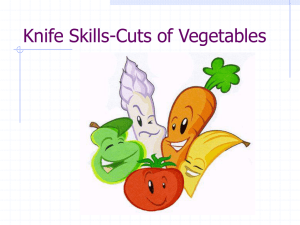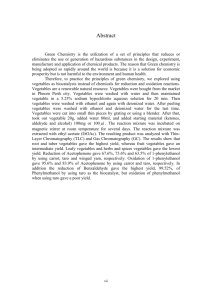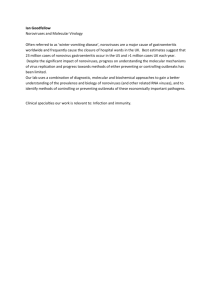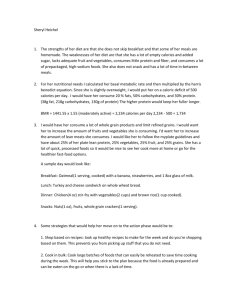short-term scientific mission - European Network for Environmental
advertisement
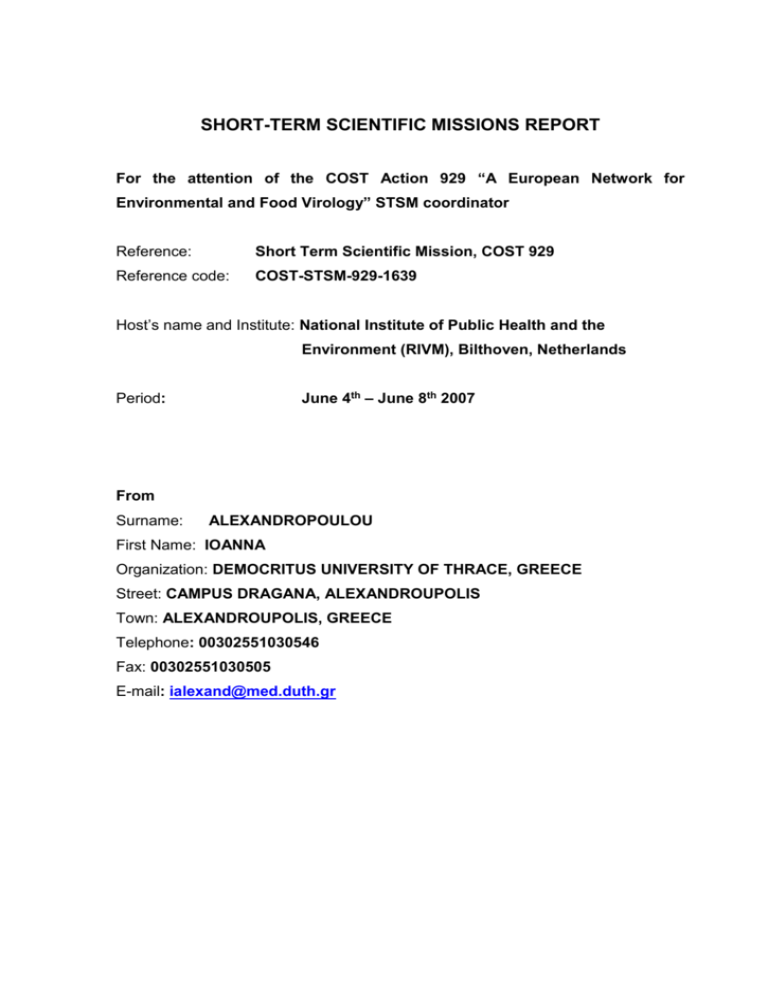
SHORT-TERM SCIENTIFIC MISSIONS REPORT For the attention of the COST Action 929 “A European Network for Environmental and Food Virology” STSM coordinator Reference: Short Term Scientific Mission, COST 929 Reference code: COST-STSM-929-1639 Host’s name and Institute: National Institute of Public Health and the Environment (RIVM), Bilthoven, Netherlands June 4th – June 8th 2007 Period: From Surname: ALEXANDROPOULOU First Name: IOANNA Organization: DEMOCRITUS UNIVERSITY OF THRACE, GREECE Street: CAMPUS DRAGANA, ALEXANDROUPOLIS Town: ALEXANDROUPOLIS, GREECE Telephone: 00302551030546 Fax: 00302551030505 E-mail: ialexand@med.duth.gr FINAL SCIENTIFIC REPORT Introduction and purpose of the visit Numerous viruses can be found in the human intestinal tract, but the viruses that are most commonly transmitted by food are noroviruses and hepatitis A virus. Various types of food have been implicated in outbreaks of viral disease e.g. shellfish, vegetables, fruits. Foods served raw can be a transmission risk for viruses: vegetables destined to the market are harvest and field packed into retail containers without being washed. Such products are often eaten raw or with minimal processing and if contaminated with pathogenic enteric viruses may represent a hazard for the health to the consumers. The control of the presence of the viruses plays an important role in rending vegetables safe for human consumption. The importance of foodborne transmission in outbreaks of viral disease due to consumption of vegetables is increasingly recognized. Moreover in 2003, ECDC notified to the EU Rapid Alert Systems the possible presence of noroviruses in vegetables harvested around Europe. To improve microbial monitoring of food quality and to assess the real role of food in viral transmission, standardized and validated methods need to be developed. Although significant progress has been made in detection of enteric virus in shellfish, much needs to be done for other foods before this goal can be reached. Puprose of the specific STSM was the acquisition of experience with the techniques used for detection of noroviruses in food samples and also the disemmination of knowledge of this technology to colleagues to the home Institute. Description of the work carried out during the visit The short-term mission of Mrs Ioanna Alexandropoulou (Democritus University of Thrace) has been performed at the RIVM,in Netherlands. During this visit, Mrs Alexandropoulou acquired the basic knowledge and technologies for the molecular detection of Norovirus contamination of vegetables. The general accomplishment of Mrs Ioanna Alexandropoulou scientific mission was to define a standardised procedure to detect enteric viruses in vegetables and improve her knowledge on the automatic molecular biology-based systems for qualitative and quantitative detection of enteric viruses (Real-Time PCR). In particular, Mrs Ioanna Alexandropoulou evaluated systems to extract and concentrate Noroviruses from vegetables, and to eliminate the presence of RTPCR inhibitors in this type of food. Moreover, she has performed different detection strategies (RT-PCR, Real-Time RT-PCR) to define the effectiveness of the different techniques to detect quantitative enteric viruse in vegetables. During the first three days, Mrs Ioanna Alexandropoulou performed elution and concentration methods to detect Noroviruses in vegetables. She acquired the methods for nucleic acid extraction from vegetables and faeces samples. The methods consisted of removal of virus from vegetables by beef-extract glycine, then removal of residual food debris by centrifugation, followed by PEG concentration of virus particles. The extraction and purification of viral RNA was done by magnetic silica method (according proposed CEN/TAG4 method), different RNA concentration and purification methods to remove RT-PCR inhibitors from vegetables and human faeces. The efficiency of the extraction was estimated by qualitative determination using RT-PCR methods and quantitative determination using Real Time PCR method. In particular she applied two step Reverse Transcription Polymerase Chain Reaction (RT-PCR). The amplicons for RT-PCR were visualised by agarose gel electrophoresis and were confirmed by Southern blot analysis. During the next two days, she compared different protocols for the developed quantitative method by Real Time RT-PCR. Primers and probe were used according to some authors. She has also used one-step RT Real Time PCR. This is a rapid and simple method which allows detection of RNA viruses in one step in the same reaction tube. This was facilitated through heat extraction of viral RNA, and the use of the thermostable enzyme which could perform reverse transcription and cDNA amplification in the same buffer system (rTth). Genogroup II Noroviruses fecal suspension was used for contamination of vegetable samples. Twenty five grams of vegetables were spiked with serial diluitions of fecal suspension to obtain final concentration of 2x103, 2x102, 2x101 RTPCR /100l. Genogroup II Noroviruses fecal suspension was used as positive control. Each contamination was repeated two times. Samples were extracted by glycine-beef extraction and by PEG concentration. Each pellet was resuspended in 500μl of phosphate buffer saline (PBS). The final extracts were used for extraction of viral RNA with magnetic silica column purification. One step RT Real Time RT-PCR were performed on each dilution. The amplifications of the DNA target obtained by Real Time RT-PCR were measured in terms of the increment in the quantity of fluorescence determinated at the end of each amplification cycle. The resuls were visualized using the software sequence detector 1.7 provided with tthe ABI Prism 7700 system (Applied BioSystem), and the standard curve was confirmated by using Microsoft Excel 2000. The results of the tests preformed on vegetables experimentally infected with concentration of NoV ranging from 103 to 101 RTPCR /100l showed that the different elution and concentration methods to detect Noroviruses in vegetables were achieved in each replicate experiment. In the future this knowledge, transferred to the lab in Greece, will help to study several aspects of the disease and will be useful to investigate the presence of enteric virus in vegetables. So far, vegetables are not controlled for viruses in Greece, so in cooperation with the Ministry of Agriculture, a cooperated project could start in the future. Description of the main results obtained The STSM has improved the skills of I. Alexandropoulou, permitting to improve her knowledge on molecular biology. In particular, she developed her competence in detection of NoV in vegetables. The techniques acquired have been mainly: 1. Application of elution and concentration methods to detect Noroviruses in vegetables. 2. Application of different RNA concentration and purification methods to detect Noroviruses in vegetables and human faeces. 3. Qualitative determination of NoV RNA in vegetables and human faeces, using RT-PCR and Real Time PCR methods. 4. Quantitative determination of NoV RNA in vegetables and human faeces, using Real Time RT-PCR methods. Future collaboration with the host institution The RIVM has been chosen as host institution because it is the most important public health institution in the Netherlands involved in the problems correlated to the presence of viruses in vegetables. The host laboratory also has a wide experience in standardised procedures to detect enteric viruses in vegetables by using molecular methods. Thanks to the STMS, a collaboration between the research groups in RIVM and Democritus University of Thrace has already started, and this relationship will lead to an exchange of know-how, materials, specimens and techniques. I would be pleased to provide further information if requested to do so. Date: 8 June 2007 Signature : Ioanna Alexandropoulou I enclose the Confirmation by the host institute of the successful execution of the mission
